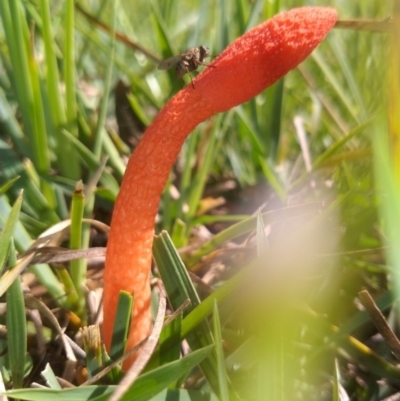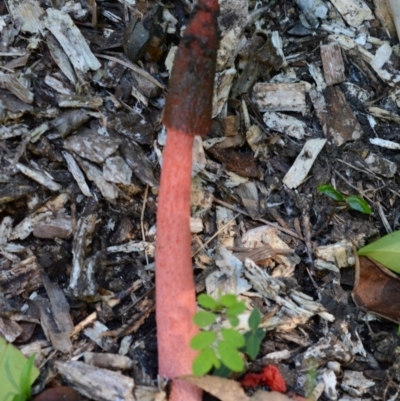Phallus rubicundus (Phallus rubicundus)
Phallus rubicundus, when mature, shows a cylindrical stem in some shade of red atop which there is a closely-fitting cap. It may reach 15 cm in height (but often is less) and the diameter is 1-2 cm. The stem is much like blown foam and is largely empty and the cap carries a smelly slime which holds the spores.
This is a stinkhorn and, like all stinkhorns, starts out like a small, gelatinous egg (perhaps 2-3 cm in length). The 'egg shell' is a dirty whitish membrane that holds the immature fruitbody. At maturity the stem expands, breaking the membrane. Occasionally a small fragment of that membrane may remain stuck to the top of the stem, but in general the only remnant of the membrane is around the base of the stem (as a cup-like surround, technically a volva). You may have to scrape away some soil or leaf litter to reveal the volva. The smell and the red colour (resembling fresh meat) attract dung-loving or carrion-loving invertebrates which carry the spores further afield.
The original description of this species was published in 1811, by Louis Augustin Guillaume Bosc, based on a specimen found in North America and here is a translation of the original French text:
The stem is fusiform, spongy, red, surrounded at the base by a small grey volva; the cap is conical, smooth, brown and topped with a small oval hole. This species grows in autumn and is found only in the driest areas of lower Carolina. It gives forth a very disagreeable odour. The volva contains a jelly; the stem is perforated by numerous random and irregular holes. The cap is covered with a slime that melts away at maturity or a few hours after it has been collected.
Fusiform means wider in the middle than at the top or the bottom. For anyone wanting to read the original (available at more than one site online), see Magazin der Gesellschaft Naturforschenden Freunde Berlin, Volume 5 (1811), page 86. Bosc included an illustration (see figure 8 of plate 6 in that volume) and he called this fungus Satyrus rubicundus, the change in genus dating to 1823.
Phallus rubicundus is listed in the following regions:
Canberra & Southern Tablelands | Southern Highlands | South Coast
Species information
- Phallus rubicundus Scientific name
- Phallus rubicundus Common name
- Not Sensitive
- Local native
- Non-invasive or negligible
- Up to 844.39m Recorded at altitude
- Machine learning
Location information
-
Maps
ANU Liversidge Precinct Bicentennial Park Bluetts Block (402, 403, 12, 11) Brownlow Hill Conservation Callum Brae Crace Grasslands Denman Prospect 2 Estate Deferred Area (Block 12) Hughes Garran Woodland Illilanga & Baroona Kama Lake Burley Griffin West Molonglo River Reserve Mount Ainslie to Black Mountain Mount Majura Mulligans Flat Namadgi National Park Piney Ridge Red Hill to Yarralumla Creek The Fair, Watson Urambi Hills Wandiyali-Environa Conservation Area Wollondilly Local Government Area -
Survey points
AIN2118 AIN2201 AIN2202 AIN2203 AIN2204 AIN2293 AIN2378 AIN2379 AIN2468 AIN2469 AIN2555 AIN2556 AIN2557 AIN2558 AIN2649 AIN2650 AIN2651 AIN2734 AIN2735 AIN2736 AIN2827 AIN2828 AIN2829 AIN2830 AIN2922 AIN3018 AIN3107 BM2116 BM2117 BM2825 BM2826 BM2920 BM3012 BM3013 BM3014 BRUCE1833 BRUCE1892 BRUCE1893 BRUCE1894 BULLEN4534 BULLEN4641 BULLEN4642 BULLEN4643 BULLEN4644 BULLEN4645 BULLEN4760 BULLEN4761 BULLEN4762 BULLEN4763 BULLEN4879 BULLEN4880 BULLEN4881 BULLEN4882 BULLEN4987 BULLEN4988 BULLEN4989 BULLEN5093 BULLEN5094 BULLEN5095 BULLEN5096 BULLEN5209 BULLEN5321 BULLEN5322 BULLEN5323 BULLEN5423 BULLEN5516 BULLEN5517 BULLEN5592 BULLEN5593 BULLEN5594 BULLEN5595 BULLEN5596 BULLEN5597 BULLEN5677 BULLEN5678 BULLEN5679 BULLEN5680 BULLEN5681 BULLEN5682 BULLEN5683 BULLEN5765 BULLEN5766 BULLEN5767 BULLEN5768 BULLEN5838 BULLEN5839 BULLEN5840 BULLEN5906 BULLEN5907 BULLEN5974 BULLEN5975 BULLEN6040 BULLEN6041 BULLEN6042 BULLEN6113 BULLEN6181 BULLEN6182 BULLEN6183 BULLEN6184 BULLEN6185 BULLEN6256 BULLEN6257 BULLEN6258 BULLEN6259 BULLEN6260 BULLEN6261 BULLEN6262 BULLEN6324 BULLEN6325 BULLEN6326 BULLEN6327 BULLEN6328 BULLEN6329 BULLEN6330 BULLEN6333 BULLEN6385 BULLEN6386 BULLEN6387 BULLEN6388 BULLEN6389 BULLEN6390 BULLEN6391 BULLEN6392 BULLEN6393 BULLEN6442 BULLEN6443 BULLEN6444 BULLEN6445 BULLEN6446 BULLEN6447 BULLEN6448 BULLEN6449 BULLEN6450 BULLEN6451 BULLEN6452 BULLEN6498 BULLEN6499 BULLEN6500 BULLEN6501 BULLEN6502 BULLEN6503 BULLEN6504 BULLEN6505 BULLEN6506 BULLEN6507 BULLEN6556 BULLEN6557 BULLEN6558 BULLEN6559 BULLEN6560 BULLEN6561 BULLEN6562 BULLEN6563 BULLEN6564 BULLEN6565 BULLEN6566 BULLEN6567 BULLEN6568 BULLEN6569 BULLEN6628 BULLEN6629 BULLEN6630 BULLEN6631 BULLEN6632 BULLEN6633 BULLEN6634 BULLEN6635 BULLEN6636 BULLEN6637 BULLEN6638 BULLEN6693 BULLEN6694 BULLEN6695 BULLEN6696 BULLEN6697 BULLEN6698 BULLEN6699 BULLEN6700 BULLEN6701 BULLEN6702 BULLEN6703 BULLEN6704 BULLEN6705 BULLEN6762 BULLEN6763 BULLEN6764 BULLEN6765 BULLEN6766 BULLEN6767 BULLEN6768 BULLEN6769 BULLEN6770 BULLEN6771 BULLEN6830 BULLEN6831 BULLEN6832 BULLEN6833 BULLEN6834 BULLEN6835 BULLEN6836 BULLEN6838 BULLEN6839 BULLEN6892 BULLEN6893 BULLEN6894 BULLEN6895 BULLEN6896 BULLEN6897 BULLEN6898 BULLEN6900 BULLEN6901 BULLEN6955 BULLEN7004 BULLEN7005 BULLEN7006 BULLEN7007 BULLEN7061 BULLEN7119 BULLEN7120 BULLEN7121 BULLEN7172 BULLEN7176 BULLEN7177 BULLEN7220 BULLEN7221 BULLEN7222 BULLEN7224 BULLEN7225 BULLEN7226 BULLEN7269 BULLEN7270 BULLEN7271 BULLEN7272 BULLEN7273 BULLEN7274 BULLEN7275 BULLEN7276 BULLEN7277 BULLEN7278 BULLEN7279 BULLEN7328 BULLEN7329 BULLEN7330 BULLEN7331 BULLEN7332 BULLEN7333 BULLEN7334 BULLEN7335 BULLEN7387 BULLEN7388 BULLEN7389 BULLEN7390 BULLEN7391 BULLEN7392 BULLEN7393 BULLEN7394 BULLEN7396 BULLEN7442 BULLEN7443 BULLEN7444 BULLEN7445 BULLEN7446 BULLEN7447 BULLEN7448 BULLEN7449 BULLEN7450 BULLEN7451 BULLEN7452 BULLEN7453 BULLEN7501 BULLEN7502 BULLEN7503 BULLEN7506 BULLEN7507 BULLEN7508 BULLEN7509 BULLEN7510 BULLEN7511 BULLEN7512 BULLEN7558 BULLEN7559 BULLEN7564 BULLEN7566 BULLEN7567 BULLEN7568 BULLEN7599 BULLEN7608 BULLEN7641 BULLEN7642 BULLEN7643 BULLEN7652 BULLEN7698 BULLEN7699 BULLEN7766 BULLEN7767 BULLEN7830 BULLEN7831 BULLEN7895 BULLEN7896 BULLEN7897 BULLEN7898 BULLEN7899 BULLEN7900 BULLEN7964 BULLEN7965 BULLEN7966 BULLEN7967 BULLEN7968 BULLEN7969 BULLEN7970 BULLEN7971 BULLEN8044 BULLEN8045 BULLEN8046 BULLEN8047 BULLEN8048 BULLEN8049 BULLEN8050 BULLEN8051 BULLEN8052 BULLEN8053 BULLEN8133 BULLEN8134 BULLEN8135 BULLEN8136 BULLEN8137 BULLEN8138 BULLEN8139 BULLEN8140 BULLEN8141 BULLEN8228 BULLEN8229 BULLEN8230 BULLEN8231 BULLEN8232 BULLEN8233 BULLEN8234 BULLEN8235 BULLEN8322 BULLEN8323 BULLEN8327 BULLEN8328 BULLEN8414 BULLEN8415 BULLEN8589 BULLEN8673 CB5861 CB6074 CB6146 CB6221 CB6222 CB6223 CB6294 CNP1400 CNP6773 COOL5991 COOL6060 COOL6132 COOL6133 COOL6134 COOL6135 COOL6204 COOL6205 COOL6207 COOL6280 COOL6281 COOL6282 COOL6283 COOL6346 COOL6347 COOL6348 COOL6407 CRACE1036 CRACE1089 CRACE1203 CRACE1267 CRACE1268 CRACE1269 CRACE1270 CRACE1336 CRACE1337 CRACE1397 DUN408 DUN437 DUN463 DUN465 DUN492 DUN495 DUN496 DUN524 DUN526 FAR6581 FAR6649 FAR6715 FAR6716 FAR6781 FAR6785 FAR6843 FAR6844 FAR6845 FAR6846 FAR6904 FAR6905 FAR6906 FAR6907 FAR6959 GIB10213 GIB10288 GIG10908 GIG10994 GIG11389 GIG11540 GIG11541 GIG11542 GIG11543 GIG11544 GIG11623 GIG11624 GIG11625 GIG11708 GIG11709 GIG11710 GIG11711 GIG11787 GIG11788 GIG11789 GIG11790 GIG11791 GIG11792 GIG11793 GIG11872 GIG11873 GIG11874 GIG11875 GIG11876 GIG11877 GIG11878 GIG11879 GIG11952 GIG11953 GIG11956 GIG11957 GIG11958 GIG11959 GIG12031 GIG12032 GIG12033 GIG12114 GIG12115 GIG12116 GIG12117 GIG12118 GIG12119 GIG12187 GIG12188 GIG12189 GIG12190 GIG12191 GIG12192 GIG12193 GIG12194 GIG12262 GIG12263 GIG12264 GIG12265 GIG12266 GIG12267 GIG12268 GIG12269 GIG12336 GIG12337 GIG12338 GIG12339 GIG12340 GIG12341 GIG12342 GIG12411 GIG12412 GIG12413 GIG12414 GIG12415 GIG12490 GIG12491 GIG12492 GIG12493 GIG12494 GIG12495 GIG12575 GIG12576 GIG12577 GIG12578 GIG12579 GIG12655 GIG12656 GIG12657 GIG12658 GIG12740 GIG12741 GIG12742 GIG12743 GIG12822 GIG12823 GIG12824 GIG12902 GIG12903 GIG12904 GIG12989 GIG12990 GIG12991 GIG13077 GIG13078 GIG13079 GIG13156 GIG13157 GIG13158 GIG13240 GIG13241 GIG13242 GIG13325 GIG13326 GIG13328 GIG13489 GIN1122 GIN1123 GIN1124 GIN1125 GIN1181 GIN1182 GIN1183 GIN1184 GIN1185 GIN1186 GIN1187 GIN1248 GIN1249 GIN1250 GIN1251 GIN1253 GIN1254 GIN1314 GIN1315 GIN1316 GIN1317 GIN1318 GIN1319 GIN1375 GIN1376 GIN1377 GIN1378 GIN1432 GIN1433 GIN1434 GIN1435 GIN1489 GOO379 GOO407 GOO434 GOO435 GOO458 GOO459 GOO460 GOO486 GOO487 GOO488 GOO516 GOO517 GOO518 GOO519 GOO547 GOO548 GOO549 GOO550 GOO578 GOO579 GOO580 GOO581 GOO582 GOO583 GOO584 GOO615 GOO616 GOO617 GOO618 GOO645 GOO646 GOO647 GOO648 GOO649 GOO672 GOO673 GOO695 GOO696 GOO697 GOO698 GOO727 GOO728 GOO753 GOO754 GOO784 GOO785 GOO786 GOO787 GOO788 GOO789 GOO816 GOO817 GOO818 GOO819 GOO820 GOO850 GOO851 GOO852 GOO853 GOO883 GOO884 GUN723 GUN724 GUN743 GUN744 GUN745 GUN746 GUN747 GUN771 GUN772 GUN773 GUN774 GUN775 GUN804 GUN805 GUN806 GUN807 GUN808 GUN809 GUN835 GUN836 GUN837 GUN838 GUN868 GUN869 GUN870 GUN871 GUN872 GUN903 GUN904 GUN905 GUN906 GUN907 GUN948 ISAACS5995 ISAACS5996 ISAACS5997 ISAACS5998 ISAACS6067 ISAACS6068 ISAACS6069 ISAACS6070 ISAACS6215 ISAACS6288 ISAACS6289 ISAACS6412 ISAACS6413 ISAACS6469 ISAACS6587 ISAACS6652 ISAACS6653 ISAACS6718 ISAACS6720 ISAACS6721 ISAACS6722 ISAACS6788 ISAACS6848 ISAACS6909 ISAACS6910 ISAACS6911 JAR586 JAR650 JAR651 JAR675 JAR701 JAR702 Jerrabomberra Wetlands4095 JW6224 JW6299 JW6360 JW6361 JW6423 JW6478 JW6530 JW6531 JW6595 JW6660 JW6661 JW6663 JW6726 JW6727 JW6728 JW6795 KOW3138 KOW3411 KOW3857 MAJ1100 MAJ1150 MAJ1151 MAJ1215 MAJ1216 MAJ1278 MAJ1279 MAJ1341 MAJ1342 MAJ1343 MAJ1402 MAJ1403 MAJ1404 MAJ1454 MAJ1455 MAJ1456 MAJ1457 MAJ1458 MAJ1459 MAJ1460 MAJ1509 MAJ1510 MAJ1511 MAJ1560 MAJ1561 MAJ1562 MAJ1609 MAJ1655 MAJ1709 MAJ1710 MAJ1896 MAJ1897 MAJ1898 MAJ1899 MAJ1968 MAJ1969 MEL8073 MEL8163 MEL8165 MEL8256 MEL8257 MEL8258 MEL8259 MEL8260 MEL8351 MEL8352 MEL8353 MEL8443 MEL8444 MEL8538 MEL8618 MEL8779 MEL8780 MEL8863 MEL8944 MEL9027 MEL9176 MEL9256 MEL9335 MOL4586 MOL4692 MOL4693 MOL4695 MOL4696 MOL4697 MOL4698 MOL4808 MOL4809 MOL4810 MOL4811 MOL4814 MOL4926 MOL4927 MOL4930 MOL5027 MOL5028 MOL5031 MOL5137 MOL5138 MOL5139 MOL5141 MOL5142 MOL5143 MOL5144 MOL5145 MOL5252 MOL5255 MOL5256 MOL5258 MOL5259 MOL5260 MOL5262 MOL5263 MOL5370 MOL5371 MOL5372 MOL5377 MOL5378 MOL5379 MOL5380 MOL5381 MRC1012 MRC1013 MRC1014 MRC1064 MRC1065 MRC1066 MRC1118 MRC1119 MRC1179 MRC1180 MRC1245 MRC1246 MRC1247 MRC1308 MRC1311 MRC1312 MRC1313 MRC1369 MRC1370 MRC1371 MRC1372 MRC1373 MRC1374 MRC1427 MRC1428 MRC1429 MRC1430 MRC1431 MRC1488 MRC4535 MRC926 MRC968 MRR1636 MRR1637 MRR1638 MRR1686 MRR1687 MRR1688 MRR1746 MRR1747 MRR1748 MRR1809 MRR1810 MRR1811 MRR1812 MRR1872 MRR1873 MRR1874 MRR1875 MRR1876 MRR1881 MRR1882 MRR1883 MRR1947 MRR1948 MRR1949 MRR1950 MRR1951 MRR1952 MRR1953 MRR1954 MRR1960 MRR2025 MRR2026 MRR2027 MRR2028 MRR2029 MRR2030 MRR2031 MRR2032 MRR2039 MRR2097 MRR2098 MRR2099 MRR2100 MRR2101 MRR2102 MRR2103 MRR2187 MRR2188 MRR2194 MRR2272 MRR2273 MRR2274 MRR2275 MRR2279 MRR2355 MRR2356 MRR2357 MRR2358 MRR2359 MRR2360 MRR2361 MRR2362 MRR2363 MRR2445 MRR2446 MRR2447 MRR2448 MRR2449 MRR2450 MRR2451 MRR2452 MRR2531 MRR2533 MRR2534 MRR2535 MRR2536 MRR2537 MRR2538 MRR2626 MRR2627 MRR2628 MRR2629 MRR2630 MRR2717 MRR2718 MRR2805 MRR2806 MRR2807 MRR2808 MRR2904 MRR2906 MRR2996 MRR2997 MRR3196 MRR3286 MRR3376 MRR3377 MRR3469 MRR3470 MRR3568 MRR3569 MRR3665 MRR3751 MRR3752 MRR3753 MRR3754 MRR3830 MRR3915 MRR3916 MRR3917 MRR3999 MRR4090 MRR4091 MRR4092 MRR4183 MRR4184 MRR4269 MRR4270 MRR4359 MUG5703 MUG5708 MUG5786 MUG5787 MUG5788 MUG5858 MUG5859 MUG5860 MUG5927 MUG5999 MUG6072 MUL571 MUL572 MUL573 MUL574 MUL608 MUL609 MUL610 MUL611 MUL639 MUL640 MUL641 MUL642 MUL667 MUL668 MUL669 MUL690 MULLIGANS131 MULLIGANS146 MULLIGANS166 MULLIGANS167 MULLIGANS168 MULLIGANS169 MULLIGANS190 MULLIGANS191 MULLIGANS192 MULLIGANS193 MULLIGANS209 MULLIGANS210 MULLIGANS223 MULLIGANS235 MULLIGANS236 MULLIGANS249 MULLIGANS250 MULLIGANS251 MULLIGANS252 MULLIGANS270 MULLIGANS271 MULLIGANS272 MULLIGANS273 MULLIGANS274 MULLIGANS291 MULLIGANS292 MULLIGANS293 MULLIGANS310 MULLIGANS311 MULLIGANS312 MULLIGANS348 MULLIGANS349 MULLIGANS350 MULLIGANS351 MULLIGANS352 MULLIGANS375 MULLIGANS376 MULLIGANS377 MULLIGANS378 MULLIGANS402 MULLIGANS403 MULLIGANS404 MULLIGANS405 MULLIGANS406 MULLIGANS428 MULLIGANS429 MULLIGANS430 MULLIGANS431 MULLIGANS432 MULLIGANS433 MULLIGANS456 MULLIGANS485 MULLIGANS515 MULLIGANS546 NAAS14021 OAK5111 OAK5443 OAK5533 OAK5614 OCO1654 OCO1706 OCO1769 PAINTER2113 PAINTER2290 PAINTER2372 PAINTER2373 PAINTER2375 PAINTER2464 PAINTER2465 PERC606 PERC634 PERC635 PERC636 PERC663 PERC664 PERC687 PERC688 PIN1830 PLEAS3203 PLEAS3293 PLEAS3483 PLEAS3484 PLEAS3485 PLEAS3576 RED4564 RED4676 RED4677 RED4790 RED4791 RED5007 RED5618 RED5619 RED5705 RED5706 ROB10035 ROB10036 ROB10037 ROB10038 ROB10039 ROB10040 ROB10041 ROB10042 ROB10112 ROB10113 ROB10114 ROB10115 ROB10116 ROB10117 ROB10118 ROB10184 ROB10185 ROB10186 ROB10187 ROB10188 ROB10189 ROB10190 ROB10191 ROB10192 ROB10259 ROB10260 ROB10261 ROB10262 ROB10263 ROB10264 ROB10265 ROB10266 ROB10267 ROB10336 ROB10337 ROB10338 ROB10339 ROB10340 ROB10341 ROB10342 ROB10343 ROB10344 ROB10345 ROB10416 ROB10417 ROB10418 ROB10419 ROB11172 ROB11249 ROB11250 ROB11324 ROB11325 ROB11326 ROB11401 ROB11402 ROB11403 ROB11404 ROB11405 ROB11474 ROB11475 ROB11554 ROB11635 ROB11636 ROB11719 ROB11720 ROB11721 ROB11722 ROB11799 ROB11800 ROB11801 ROB11802 ROB11880 ROB11881 ROB11882 ROB11883 ROB11960 ROB11961 ROB11962 ROB11963 ROB12034 ROB12035 ROB12036 ROB12120 ROB9408 ROB9409 ROB9488 ROB9489 ROB9490 ROB9491 ROB9492 ROB9493 ROB9563 ROB9564 ROB9565 ROB9566 ROB9567 ROB9627 ROB9628 ROB9629 ROB9630 ROB9631 ROB9632 ROB9633 ROB9690 ROB9691 ROB9692 ROB9693 ROB9694 ROB9695 ROB9696 ROB9760 ROB9761 ROB9762 ROB9763 ROB9764 ROB9829 ROB9830 ROB9831 ROB9832 ROB9833 ROB9834 ROB9897 ROB9898 ROB9899 ROB9900 ROB9901 ROB9902 ROB9968 ROB9969 ROB9970 ROB9971 ROB9972 ROB9973 STONE1737 STONE1799 STONE1800 STONE1863 STONE1864 STONE1935 STONE2010 STONE2011 STONE2012 STONE2080 STONE2081 STONE2164 STONE2165 STONE2166 STONE2167 STONE2251 STONE2252 STONE2335 STONE2336 STONE2337 STONE2426 STONE2427 STONE2512 STONE2513 STONE2602 STONE2603 STONE2604 STONE2696 STONE2697 STONE2783 STONE2784 STONE2879 STONE2882 STONE2883 STONE2968 STONE2969 STONE2970 STONE2972 STONE2973 STONE3073 STONE3074 STONE3075 STONE3076 STONE3077 STONE3169 STONE3170 STONE3171 STONE3172 STONE3173 STONE3264 STONE3265 STONE3266 STONE3267 STONE3268 STONE3269 STONE3351 STONE3352 STONE3353 STONE3354 STONE3355 STONE3356 STONE3357 STONE3444 STONE3545 STONE3641 STONE3642 STONE3643 STONE3644 STONE3645 STONE3731 STONE3732 STONE3733 STONE3734 STONE3811 STONE3812 STONE3813 STONE3890 STONE3891 STONE3892 STONE3893 STONE3974 STONE3975 STONE3976 STONE3977 STONE4065 STONE4066 STONE4067 STONE4159 STONE4160 STONE4161 STONE4162 STONE4246 STONE4247 STONE4337 SWAMP1419 SWAMP1420 SWAMP1421 SWAMP1422 SWAMP1476 SWAMP1477 SWAMP1478 SWAMP1479 SWAMP1480 SWAMP1484 SWAMP1529 SWAMP1530 SWAMP1531 SWAMP1532 SWAMP1534 SWAMP1535 SWAMP1578 SWAMP1580 SWAMP1581 SWAMP1584 TAY5857 TAY5925 TAY5994 TAY6064 TAY6137 TAY6138 TAY6139 TAY6211 TAY6212 TAY6213 TAY6287 TAY6351 TAY6352 TAY6409 TAY6410 TAY6465 TAY6466 TAY6519 TAY6575 TAY6576 TAY6710 TAY6711 TAY6712 TID7669 TID7670 TID7733 TID7734 TID7735 TID7736 TID7798 TID7799 TID7800 TID7801 TID7866 TID7867 TID7931 TID7932 TID7933 TID7934 TID7935 TID8010 TID8011 TID8012 TID8013 TID8014 TID8015 TID8016 TID8017 TID8099 TID8100 TID8101 TID8102 TID8103 TID8104 TID8105 TID8106 TID8107 TID8108 TID8195 TID8196 TID8197 TID8198 TID8199 TID8200 TID8201 TID8202 TID8203 TID8204 TID8205 TID8291 TID8292 TID8293 TID8294 TID8295 TID8296 TID8381 TID8382 TID8383 TID8384 TID8385 TID8386 TID8387 TID8472 TID8473 TID8474 TID8475 TID8476 TID8477 TID8562 TID8563 TID8564 TID8565 TID8566 TID8645 TID8646 TID8647 TID8648 TID8649 TID8728 TID8729 TID8730 TID8731 TID8808 TID8809 TID8888 TID8967 TID8968 TID9049 TID9050 TID9051 TID9122 TID9123 TID9194 TID9195 TID9196 TID9197 TID9198 TID9199 TID9200 TID9271 TID9272 TID9273 TID9274 TID9275 TID9276 TID9277 TID9351 TID9352 TID9353 TID9354 TID9355 TID9356 TID9357 TID9433 TID9434 TID9435 TID9436 TUG8528 TUG8611 TUG8612 TUG8615 TUG8693 TUG8694 TUG8695 TUG8696 TUG8697 TUG8772 TUG8773 TUG8774 TUG8775 TUG8776 TUG8857 TUG8858 TUG8861 TUG8862 TUG8937 TUG8938 TUG8939 TUG8940 TUG8942 TUG8943 TUG9017 TUG9018 TUG9019 TUG9020 TUG9022 TUG9023 TUG9095 TUG9096 TUG9097 URA7014 URA7070 URA7071 URA7072 URA7129 URA7130 URA7131 URA7180 URA7181 URA7182 URA7183 URA7228 URA7229 URA7230 URA7280 URA7281 URA7336 URA7337 URA7338 URA7395 WH6786 WH6908 WH6961 WH6962 WH6963 WH6964 WH7019 WH7020 WH7021 WH7075 WH7076 WH7133 WH7134 WH7135 WH7136 WH7186 WH7187 -
Places
Acton, ACT Braidwood, NSW Denman Prospect, ACT Orangeville, NSW



































































































